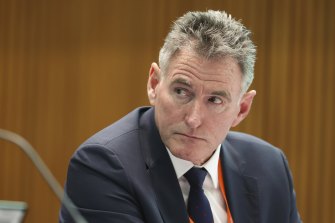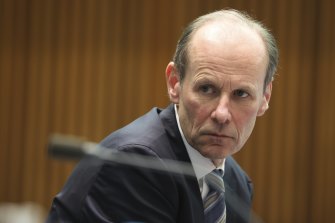A 30b bank buyback bonanza in store for investors
Australian bank shareholders will be awash with cash this year as the big four are on track to serve up big profits, hefty share buybacks and fat dividends.
It is in sharp contrast to last year when the banks were put on a short leash by the prudential regulator amid fears the coronavirus pandemic would devastate the economy, triggering a recession or depression with banks in the front line.

NAB chief executive Ross McEwan launches a buyBack for shareholdersCredit:Alex Ellinghausen
Fast forward to 2021 and the economic hit was nowhere near as bad. The Australian sharemarket is booming, property prices are at record highs and the Australian Prudential Regulation Authority (APRA) dumped its strict capital rules, including a 50 per cent cap on bank dividend payouts.
Besides the regulator giving the banks holiday leave on capital, another side effect of the pandemic has been the opportunity for them to rebuild a battered reputation as they agreed to waive loan repayments for six months for home borrowers and small business, and capitalise the interest payments over that period.
Almost overnight the banks went from villains, driven by greed and subject to the ignominy of a royal commission, to white knights.
On Friday, National Australia Bank set a new tone for shareholders when it announced a $2.5 billion on market share buyback. NAB followed ANZ, which weeks earlier launched a $1.5 billion buyback not long after ANZ chief executive Shayne Elliott described the bank’s capital position as “an embarrassment of richesâ€.

ANZ chief executive Shayne Elliott.Credit:Alex Ellinghausen
Elliott could have been speaking on behalf of all four major banks, which have been quietly amassing excess capital due to a confluence of factors including holding back dividends last year, selling assets including insurance and slow growth on the part of three of the four banks.
According to leading banking analyst Brett Le Mesurier who works at Velocity Trade, the banks are sitting on at least $30 billion in surplus capital available for capital returns.
He estimates that by September 30, ANZ will have $4.5 billion in excess capital, CBA $12 billion, NAB $5 billion and Westpac $8 billion. This doesn’t include ANZ and NAB’s latest buybacks.
Indeed, Le Mesurier believes the amount could be closer to $40 billion over the next two years on the basis the banks won’t grow much, they will write back bad debt provisions and Westpac sells more businesses.
The outlook is positive for banks because home loan growth is likely to continue to increase.
Banking analyst Brett Le MesurierIn the case of Westpac and CBA, which have a combined $6.5 billion in franking credits, some of the capital can be returned in an off-market buyback that attaches franking credits to the capital return to provide local investors with tax-friendly buybacks.
“The outlook is positive for banks because home loan growth is likely to continue to increase,†Le Mesurier says.
Besides putting money into the pockets of shareholders, it sends a message that the regulator is comfortable with the banks’ financial position and banking system stability, despite the latest lockdowns and prolonged shutdown in NSW.
Put simply, APRA conducted a series of stress testing of the banks last year to ensure the system was tough enough to absorb a severe shock at the same time as supplying credit into the economy.
In December, APRA’s Wayne Byres told the market that APRA had conducted a series of stress tests on the banks to gauge their ability to endure a bad crisis. This included a “severe downside scenario†where economic growth tanked 15 per cent, unemployment rose 13 per cent and house prices plummeted more than 30 per cent. The banks passed with flying colours, with APRA estimating such a crisis would result in a 5 per cent fall in the banks’ capital adequacy ratio to 6.6 per cent, which is still above the 4.5 per cent minimum requirement.
NAB boss Ross McEwan sang from the same song sheet as ANZ on Friday when he announced the buyback, carefully creating a narrative that the return of surplus capital to shareholders wasn’t at the expense of customers, who were being offered financial support affected by the pandemic.
“Our support for customers and colleagues continues through ongoing lockdowns and as the COVID-19 situation evolves,†McEwan said.
Weeks earlier ANZ’s Elliott made the same pitch. “Just as we supported our customers through previous lockdowns, we stand ready and able to provide assistance to those that need it. The strength of our business means we are well placed to fulfil the needs of our customers and the broader community while still actively managing our capital.â€
CBA and Westpac will be next.
But at the end of the day the banks still have a lot of work to do to rebuild their battered reputations. Each has its own remediation programs underway and there isn’t a lot of transparency on how some of them are going or whether they have hit obstacles.
The corporate regulator gave a timely reminder on remediation and the fees for no service scandal when it hit AMP with a civil action on Friday alleging fees for no service on corporate super accounts to the tune of $600,000.
According to ASIC, the country’s six biggest financial institutions, including the four banks, paid or offered a total of $1.2 billion in compensation to customers due to fees for no service or poor advice as at December 2020.
The final bill, including compliance costs and consulting fees, is in the billions of dollars. To put it into perspective, of ASIC’s estimate of $1.2 billion, AMP represents $187 million, which is a fraction of the $800 million AMP believes it will cost, a figure many in the industry believe is vastly undercooked.
With profit season upon us, the theme of buybacks will be common for investors of banks and mining stocks, something that is likely to keep the sharemarket rallying onwards and upwards â€" at least for now.
“Results for the second half of 2021 should beat expectations but this makes for a tougher comp for 2022,†is the overriding message of Macquarie in a note to clients about the season ahead. What happens next is anyone’s guess.
Adele Ferguson is a Gold Walkley Award winning investigative journalist. She reports and comments on companies, markets and the economy.
0 Response to "A 30b bank buyback bonanza in store for investors"
Post a Comment